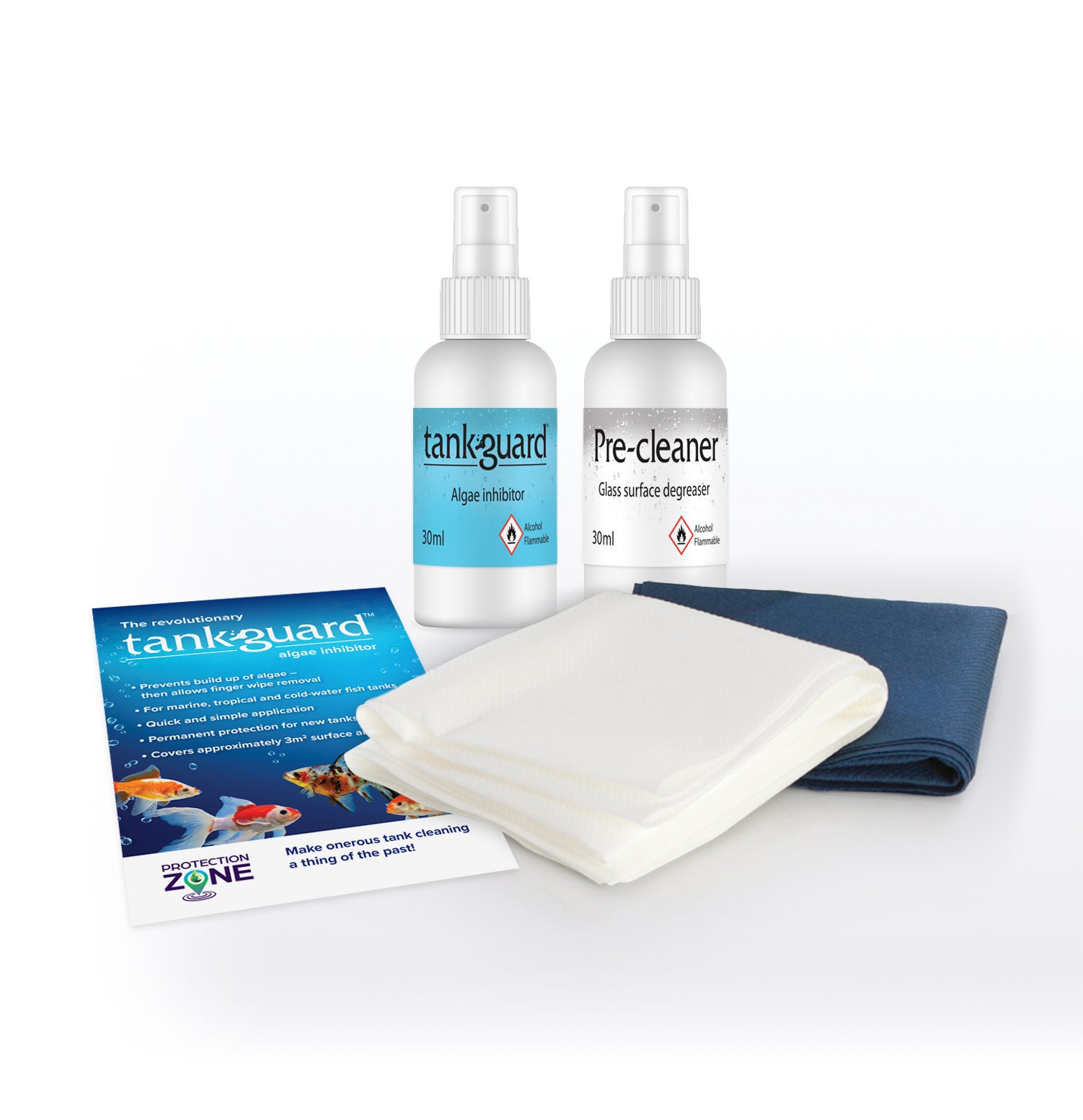TankGuard™
TankGuard™
£25.00
TankGuard™
Glass fish tank algae inhibiting coating for existing/new marine, tropical and cold-water fish tanks.
Creating a permanent finger-wipe removal of algae and greening.
Coverage: Approx’ 3m²
£ Cost / m²: £8.33 / m²
Durability: 10 year functionality when maintenance instructions are followed.
Description
The coating is crystal clear, UV stable, chemically inert and extremely durable, having both hydrophobic and oleophobic capabilities. It is unaffected by extremes of temperatures from –20°C to +450°C.
TankGuard™ Performance:
- Permanent bond that will not peel or flake, preserving the surface quality.
- Does not reduce light transmission or optical values.
- Not affected by UV bonding.
- Resists salt water corrosion.
TankGuard™ Benefits:
- Can be applied to all glass fish tanks.
- Environmentally friendly, contains no irritants or HCFCs.
- Allows finger-wipe removal of contamination.
- Certified food safe and inert by ISEGR.
Application
For both new and existing fish tanks.
TankGuard™ Care Instructions
Simply remove any light algae build-up with minor agitation using an appropriate blade or scraper whilst the tank is in use.
Additional information
| Chemical basis: | modified silicon dioxide |
|---|---|
| Layer thickness: | approx. 100-120 nm |
| Water resistance: | between 105° and 115° (20μl) |
| Oil resistance: | between 80° and 85° (20μl) |
| Slip angle: | > 25° |
| Temperature stability: | 250°C permanent, 450°C peak |
| Chemical stability: | between pH 1 and pH 13 |
| Weather resistance: | 3500h pursuant to ISO 11507 A |
| Durability (mechanical): | >20,000 cycles pursuant to ISO 11998 |
| Salt water resistant: | yes |
| Transparency: | 100% |
| Storage stability: | >2 years |
| Temperature sensitivity: | -3°C to 30°C |
| Consumption: | 5 ml/m2 |
| Application: | Drops of the liquid are applied either on a slightly absorbent cloth or directly to the substrate. Polish until the surface |
| Standard sizes: | 1 Kit |
Hazards


Danger
H225 Highly flammable liquid and vapour
H319 Causes serious eye irritation
P210 Keep away from heat, hot surfaces, sparks, open flames and other ignition sources. No smoking
P240 Ground and bond container and receiving equipment
P305 + P351 + P338 IF IN EYE: Rinse cautiously with water for several minutes. Remove contact lenses, if present and easy to do. Continue rinsing.
P337 +P313 If eye irritation persists: Get medical advice/attention
P403 +P235 Store in well-ventilated place. Keep cool.
P501 Dispose of contents /container in accordance with national regulation.
Application Video
Coming soon 😊
Application Instructions
1.Preparation of glass surface with TankGuard Pre-Clean
Ensure glass is dry, and clear of grease and dirt. Spray the inside glass surface of the dry tank with TankGuard Pre-Clean and rub the product into the glass surface with the pre-cleaning cloth (white). Divide larger tank glass panes into sections for treatment of about 0.5m² to minimise rapid evaporation of the product.
The glass is clean when streak formation is no longer evident. Apply the TankGuard coating immediately after pre-cleaning of the whole glass surface.
- Coating with TankGuard
After pre-cleaning, spray TankGuard onto the inside glass surface, ensuring good coverage. Spread the product around the glass surface with the coating cloth (blue) to ensure complete coverage of the surface.
Because of the rapid evaporation of the product, divide larger glass panes into sections for treatment of about 0.5 m². After coating the last section of the glass, polish away the surplus from the glass surface (in one operation) with the coating cloth.
Each 30 ml bottle should cover approx. 3m² of glass.
Use any excess product to treat the outside of your tank to allow easy removal of finger prints and limescale from spilt tank-water
Reaction time, quality control and maintenance Immediately after the application of TankGuard the nano-particles form a strong bond with the glass surface in a chemical reaction.
The TankGuard surface can be handled immediately after coating. Whilst rapid bonding takes place between the coating and the glass, allow 24 hrs at 20°C room temperature before filling tank for the coating to become completely inert. Once filled, your TankGuard coating is in action, immediately inhibiting the adhesion of algae.
Speed of algae growth will be dictated by conditions and content of the fish-tank and the light source.
Algae can be removed quickly and easily by agitation from a soft cleaning implement .Do not use abrasive product on the surface of the glass.
Enjoy the time you’ve saved !
Please Note: We only deliver to registered UK addresses with a valid Post Code.
We only supply to the UK from this site, contact us on + 44 (0)1691 654282 for delivery to Ireland and the rest of the world.
We send goods with an independent carrier on a 1/2 day delivery service. Please notify us if you have specific delivery requirements such as a restricted access. Failure to notify us of special delivery instructions can incur additional charges from our carriers.




